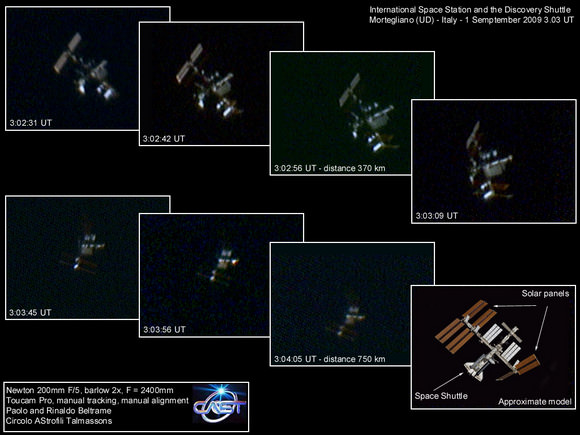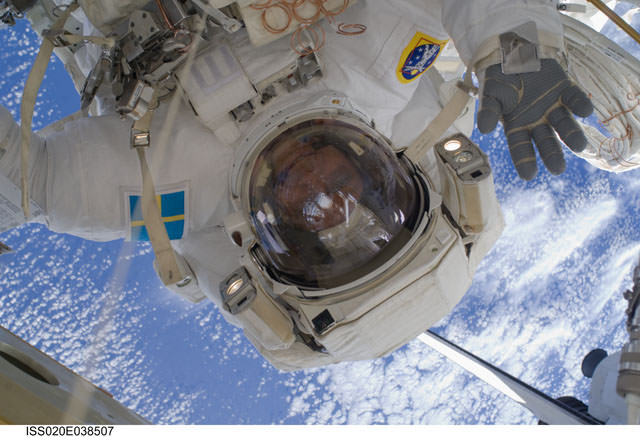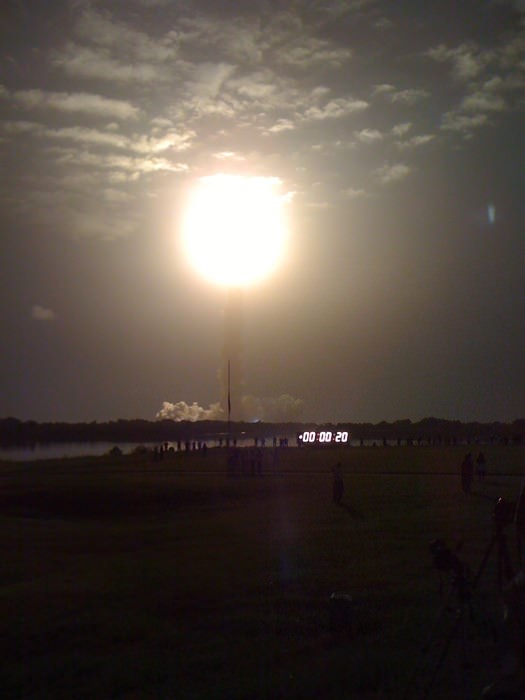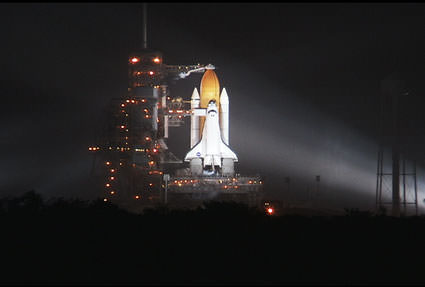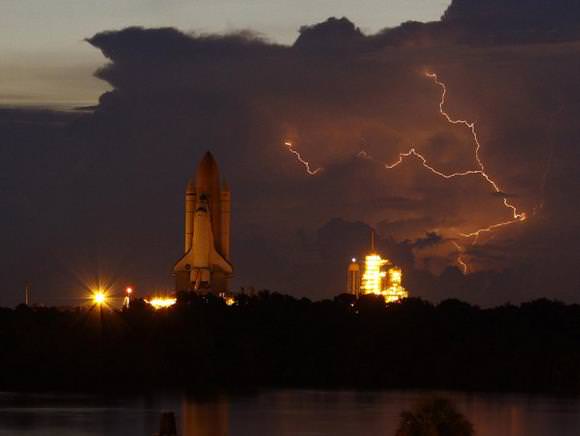There’s nothing prettier than watching the space shuttle land. Sure, it drops like a rock, a piano, a safe; but when the vehicle makes the final turn and lines up with the runway, and then the commander sticks the landing like Rick Sturckow did tonight, it’s a work of art. If you missed the landing in real time, here’s a great video of Discovery’s landing at Edwards Air Force Base in California, at 5:53 PDT on Friday, ending the 14-day mission to the International Space Station.
Continue reading “Space Shuttle Discovery Returns Home (Video)”
Great Views of the ISS and Shuttle From Earth and Space
[/caption]
Paolo Beltrame from Italy sent us this amazing montage of images he took of space shuttle Discovery docked to the ISS on September 1, 2009. See the incredible details visible of the space station and docked shuttle! Paolo is with the Circolo AStrofili Talmassons (Amateur Astronomers Club in Talmassons, or CAST) who have an impressive observatory (take a look at Paolo’s website). He took these selected images from a 2-minute movie taken with a TourcamPro webcam. As impressive as Paolo’s astrophotos are, however, he says his real passion is viewing the night sky with the naked eye. His motto is “Lasciate che i fotoni vengano a me!” (Let the photons come to me!) See a close up of Paolo’s best shot of the ISS/shuttle below, as well as images from other astrophotographers of Tuesday evening’s pass of the shuttle and ISS as they flew in tandem after Discovery undocked from the station on Tuesday afternoon. There’s also video from the shuttle’s flyaround.
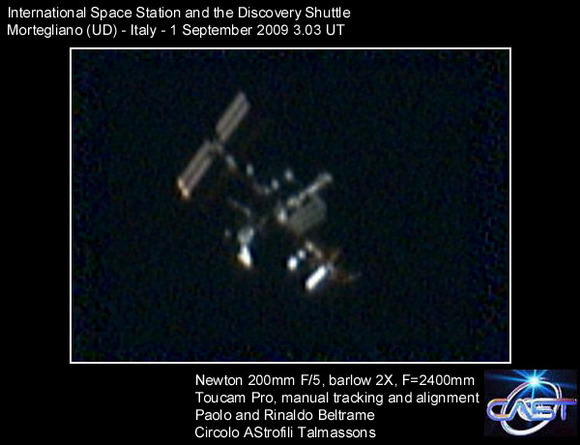
Below is Kevin Jung’s image of the ISS and shuttle as they flew in tandem over Grand Rapids, Michigan:
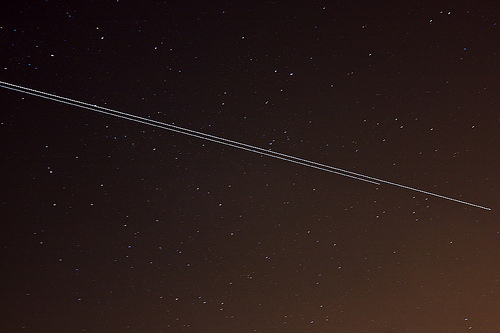
Kevin made it home just in time to take this image, and he said the pair of spacecraft went just below Lyra, and you can make out some of the other things in the field, as well. Click the image to see more of Kevin’s handiwork.
And here’s my feeble attempt to image the tandem flyover from my yard in Illinois:
Can anyone guess what the star in the picture might be?
Finally, enjoy some video of the shuttle’s fly-around of the ISS following undocking. This video just shows the the shuttle due to the lack of Ku band downlink availability. Video of the station from the orbiter was not available, but we’ll post it here later if it becomes available.
Spaceship Sighting Alert!
[/caption]
If you catch this post on Monday night, you might have a chance to see the International Space Station and Discovery while the space shuttle is still docked to the ISS. Flying as one, the station/shuttle complex is very bright and very easy to spot. But Tuesday evening you’ll be able to see double. The shuttle is scheduled to undock from the station Tuesday at 2:26 pm CDT(19:26 GMT), and if you have clear skies, you should be able to see Discovery slightly trailing the ISS. It will be a great sight — highly recommended!
How do you find out when the duo will be flying over your backyard?
NASA has a Quick and Easy Sightings by City site, where you just search for your country and city which provides local times and the location in the sky where the station will be visible.
The Heaven’s Above website is also an excellent site to find out when the ISS, as well as all sorts of other satellites and other heavenly sights will be visible. At Heaven’s Above, you can plug in your exact latitude and longitude, so if you live in a remote area, you’ll be able to have exact times and locations to look for satellites instead of relying on information for the nearest city.
Spaceweather.com has their Satellite Flyby Tracker page to provide sighting info for the US and Canada. Use this link for other countries around the world.
There’s also this very cool Google Satellite tracker.
Additionally, you can get a notification on Twitter when the space station will be zooming over your skies. Follow Twisst.
Here’s wishing everyone clear skies and great views!
Top 10 (or so) Images from STS-128
[/caption]
As the crew of the STS-128 mission pack up and prepare to get ready to undock from the International Space Station on Tuesday, it’s time to look back at the very successful mission that worked on space station construction. Here’s some of the best images of the mission.
Above, ESA astronaut Christer Fuglesang works (and waves) during the third and final EVA of the mission. Fuglesang and NASA astronaut John “Danny” Olivas installed several items and did work to prepare for the installation of Node 3, which will take place next year.
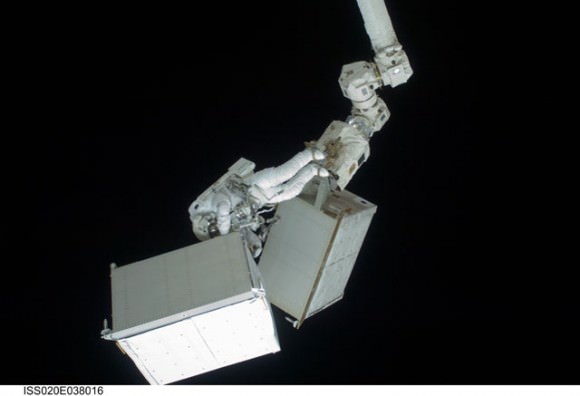
Here’s Fuglesang again, doing a little heavy lifting during the first EVA of the mission while anchored to the Canadarm2’s foot restraint. He’s carrying a new Ammonia Tank Assembly which was installed on the P-1 Truss. The old empty tank, attached to the arm, will be brought back home in the space shuttle’s payload bay, and refurbished and reused.
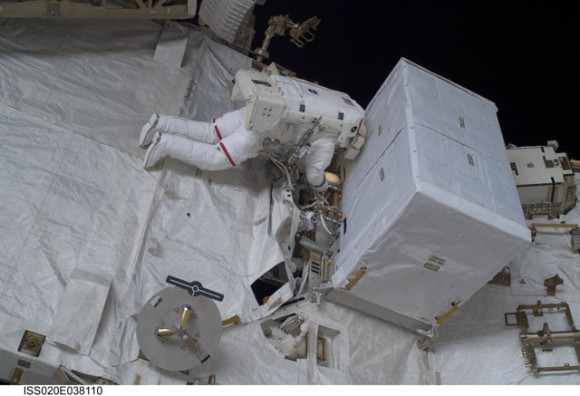
Here’s where the new Ammonia Tank Assembly was installed on the P-1 Truss. Danny Olivas is shown here putting the final touches on the first spacewalk activities.
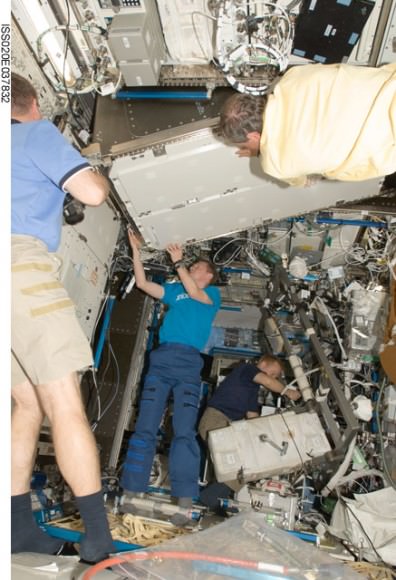
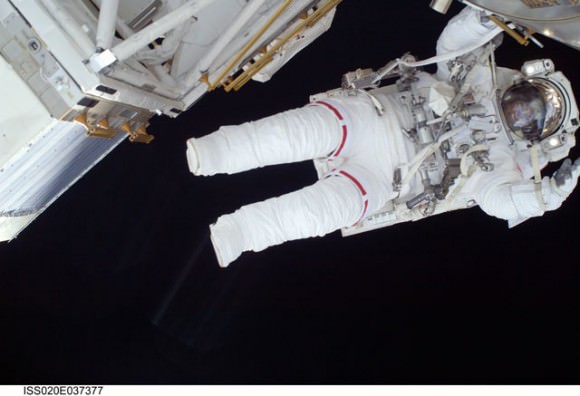
Here, Nicole Stott works during the first EVA. In addition to adding the new Ammonia Tank Assembly, Stott and Olivas retrieved the European Technology Exposure Facility (EuTEF) and Materials International Space Station Experiment (MISSE) from outside the Columbus laboratory module and installed them on Discovery’s payload bay for return to Earth. Stott will stay on board the ISS for Expedition 20 and 21.
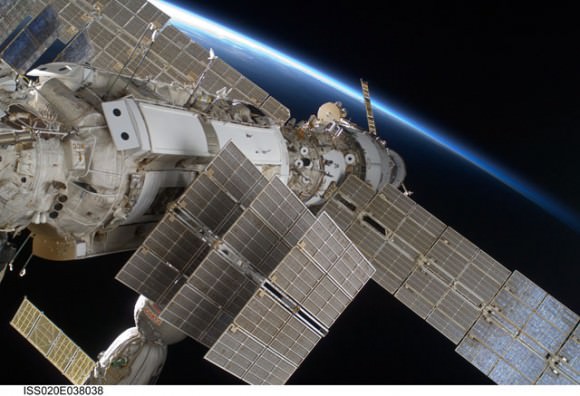
Beautiful! Part of the ISS is shown against the blackness of space and Earth’s horizon in this image photographed by one of the astronauts during the second EVA.
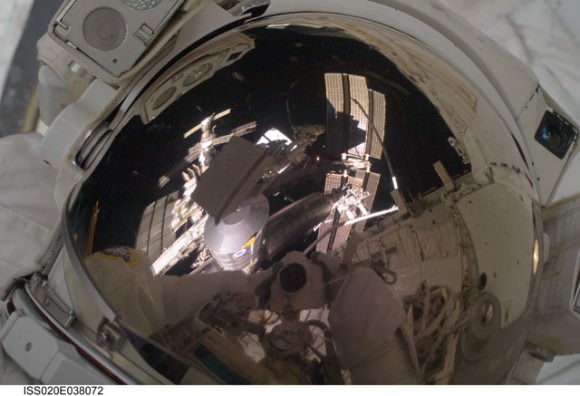
I love these visor-reflection images, and this one is especially good. Danny Olivas used his digital still camera to take a picture of his own helmet visor during the second EVA. Visible in the reflections are various components of the station, along with Christer Fuglesang anchored to a Canadarm2 mobile foot restraint.
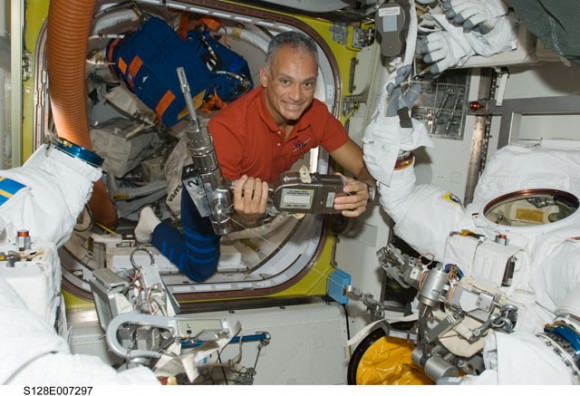
Every handyman loves tools, and NASA’s EVA tools top them all. Danny Olivas checks out a pistol grip power tool, getting it ready for use during the third EVA of the mission. Olivas participated in all three spacewalks.
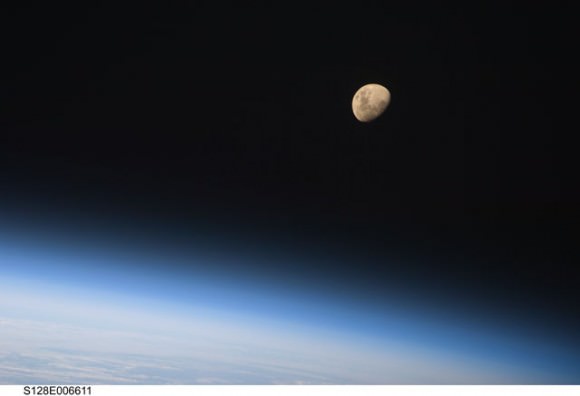
How much clearer is the view of the Moon without having to look through the atmosphere? Here, a gibbous moon is visible above Earth’s atmosphere, photographed by one of the STS-128 crew during flight day three.
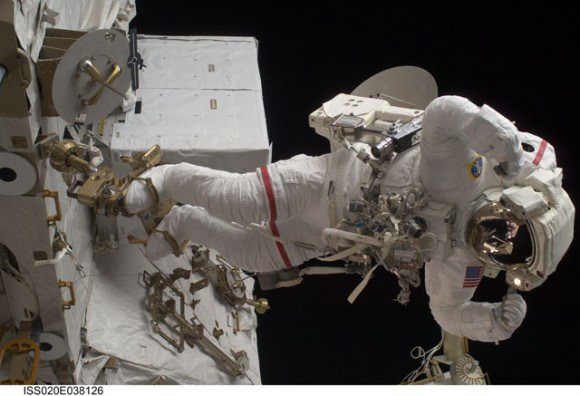
More great images from the EVAs. Above, Danny Olivas shows his strength during the second EVA and below, Nicole Stott is framed by parts of the ISS, with the solar arrays lit by the sun behind her.
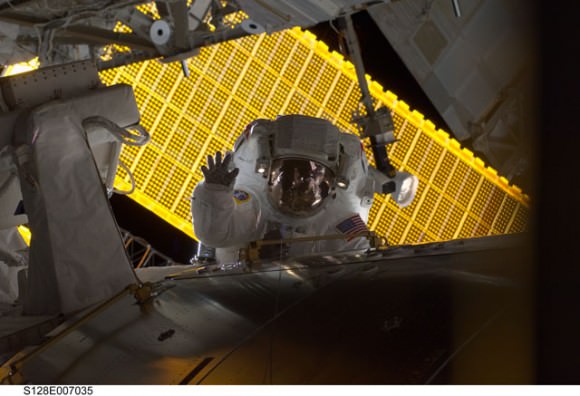
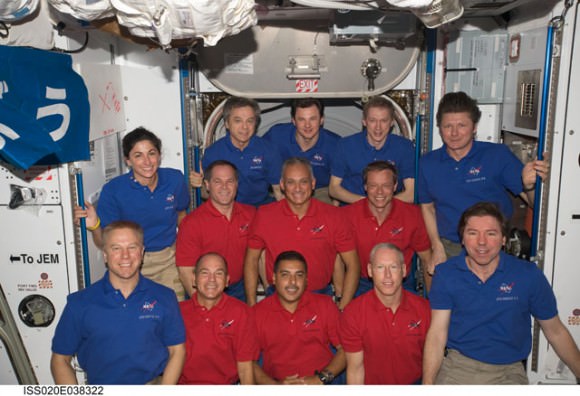
The STS-128 and Expedition 20 crewmembers found a few moments on a day between two spacewalk days to pose for some portraits on the International Space Station. The red-clad crewmembers are with STS-128. They include, front row, from the left, astronauts Rick Sturckow, Jose Hernandez and Patrick Forrester; behind them in red, are astronauts Kevin Ford, John “Danny” Olivas, with European Space Agency astronaut Christer Fuglesang. At bottom left is Tim Kopra, who joined the station crew in July but now is scheduled to return to Earth in less than a week with the Discovery astronauts. Surrounding the Discovery crew, in clockwise fashion, are the members of Expedition 20 crew, astronaut Nicole Stott, Canadian astronaut Robert Thirsk, with cosmonaut Roman Romanenko, European Space Agency astronaut Frank De Winne, cosmonaut Gennady Padalka and astronaut Michael Barratt.
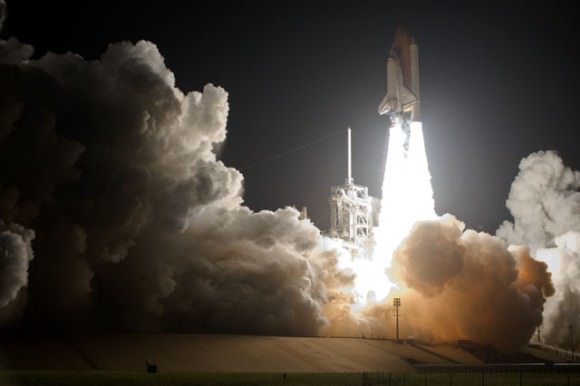
The mission began on August 28 with the nighttime launch of space shuttle Discovery. Liftoff was at 11:59 p.m. (EDT).
See all the images from STS-128 and find hi-res versions as well at NASA’s Human Space Flight Gallery.
COLBERT, Leonardo and a Neutralino Heading for Space Station
[/caption]
The third launch attempt was a charm for space shuttle Discovery and her crew. The STS-128 mission is now underway with a successful liftoff one minute before midnight, local time, from Kennedy Space Center. Discovery is carrying the Leonardo supply module to the International Space Station, and tucked away inside is the COLBERT treadmill, along with several refrigerator-sized racks of science equipment, a freezer to store research samples, a new sleeping compartment, an air purification system, and other supplies, plus another unusual object packed in Swedish astronaut Christer Fuglesang’s belongings: a theoretical particle called a neutralino.
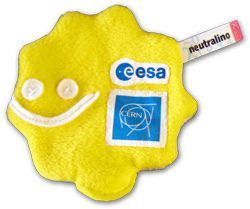
As you may have guessed, Fugelsang didn’t bring a real neutralino, but a soft toy version (see the whole collection of particles at Particle Zoo.) Fugelsang is a former CERN physicist and he wanted to take something representing CERN up to space on his mission. He chose the neutralino because it links together astrophysics and particle physics. In particle physics, the neutralino is a hypothetical particle, one of many predicted by supersymmetric theories.
The countdown and launch were textbook, without any hitches or delays. The valve that scrubbed a launch attempt earlier this week behaved normally, and while weather (which forced the first launch scrub) was a concern early during the countdown, the Florida skies eventually cleared allowing for a gorgeous nighttime liftoff. The stunning lead image is courtesy of flyingjenny on Twitter. Click the image for more of her images. Several comments from Twitterers attending the launch said night was turned into day as the shuttle ascended!
The mission is commanded by veteran astronaut Rick “C.J.” Sturckow. With him are pilot Kevin Ford and Mission Specialists Patrick Forrester, Jose Hernandez, John “Danny” Olivas, and Fugelsang, along with a new crew member for the station, Nicole Stott.
Of course, the treadmill is named after comedian Stephen Colbert, (if you’ve been living under a rock and haven’t heard about this, read about it here) and otherwise is called the Combined Operational Load Bearing External Resistance Treadmill.
Discovery is scheduled to dock with the ISS on Sunday August 30.
Sources: NASA TV, CERN
Space Shuttle Launch Scrubbed for Wednesday Morning
[/caption]
NASA officially scrubbed the second attempt for launching the STS-128 mission. “The last half an hour or so, a problem cropped up with a fill-and-drain valve in the bottom part of the shuttle, the aft part of the shuttle, related to the liquid hydrogen,” said NASA TV launch commentator Allard Beutel. “This particular valve … gave indications it did not close when it was commanded to.”
No word yet on what might be needed to replace the valve or restore it to normal operation. NASA is currently targeting the next launch attempt for Friday at 4:22 GMT (12:22 am ET) pending a review analysis on the valve issue.
NASA only has until August 30 to launch Discovery or the flight will be delayed to mid October because of upcoming Japanese and Russian space station missions and a conflict with the Air Force Eastern Range. We’ll keep you posted.
Colbert: “I’m go to launch me — Let’s light this candle!”
Posted for your enjoyment: Just hours before the scheduled launch of the STS-128 mission, NASA TV played a message from comedian Stephen Colbert, namesake of the Combined Operational Load Bearing External Resistance Treadmill (COLBERT). The treadmill is on board space shuttle Discovery, which will launch at 5:36 GMT (1:36 EDT) Tuesday morning, heading to the International Space Station for a 16 day mission. As of this writing, Discovery’s external tank has been loaded with about 500,000 gallons of liquid hydrogen and liquid oxygen in preparation for the launch. This will be Discovery’s 37th mission to space and the 30th mission of a space shuttle dedicated to the assembly and maintenance of the International Space Station.
UPDATE: The launch was scrubbed because of stormy weather. NASA will try again at 5:10 GMT (1:10 a.m. EDT) Wednesday. The most recent forecast calls for a 70 percent chance of acceptable conditions at that time.
The launch will be shown live on NASA TV. Here’s where to watch it one the web.
Spaceflightnow.com will also be hosting a live webcast with Miles O’Brien, David Waters and former astronaut Leroy Chiao starting at 9 p.m. EDT Monday evening.
South Korea Launch No Go, Shuttle Launch a Go
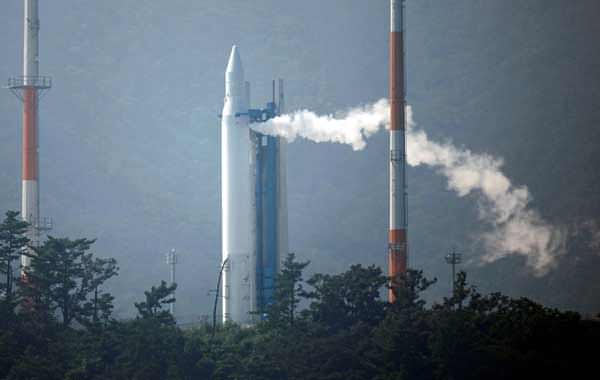
[/caption]
The launch of South Korea’s first domestic rocket launch was aborted on Wednesday just minutes before scheduled liftoff because of a technical problem, delaying South Korea’s mini space race with North Korea. The two-stage rocket, called the Naro will be South Korea’s first launch from its own territory. Officials expect another liftoff will be attempted in a few days. Another launch attempt on July 30 was also aborted. The satellite was domestically built, with help from Russia and will observe the atmosphere and ocean. The launch attempt came about four months after North Korea was widely criticized for firing its own rocket in defiance of United Nations sanctions.
Meanwhile, NASA officials have cleared space shuttle Discovery to launch on August 25 for the STS-128 mission to the International Space Station. As of now, weather is the only issue that might delay the mission.

Discovery will carry the Leonardo supply module to the International Space Station during STS-128, along with a new crew member for the station, Nicole Stott.
Launch is set for 1:36 am EDT (yes, that’s EXTREME am!) on the 25th. The good news about that hour is that launch should come well before any typical afternoon storms can brew up in the Florida skies. But then, it is hurricane season, and NASA is keeping an eye on a few tropical storms on the horizon.
Commanded by veteran astronaut Rick “C.J.” Sturckow, the STS-128 mission crew will deliver refrigerator-sized racks full of equipment, including the COLBERT treadmill, an exercise device named after comedian Stephen Colbert.
Stott will take the place of Tim Kopra, who moved into the station during STS-127. Pilot Kevin Ford and Mission Specialists Patrick Forrester, Jose Hernandez, John “Danny” Olivas and Sweden’s Christer Fuglesang round out the crew.
Sources: Discovery News, NASA
There Was a Reason Discovery’s Rollout Took Longer Than Usual…
[/caption]
Yikes! No wonder the rollout of space shuttle Discovery took a little bit longer than usual. Lightning lit up the sky above Kennedy Space Center early Tuesday morning, providing a stunning backdrop for the shuttle’s crawl to the launchpad. Usually the trip takes about six hours, but various weather-related concerns slowed the move out past 11 hours. Lightning delayed Discovery’s exit from the Vehicle Assembly Building for about 2 hours, and then mud from recent thunderstorms forced the crawler to stop repeatedly so engineers could clean out the giant treads on the huge 5.5 million-pound (2.4 million-kg) vehicle that hauls shuttles out to the launch pad. Discovery is scheduled to launch on August 25 for the STS-128 mission to the ISS. Of interest is that this mission will bring the C.O.L.B.E.R.T treadmill to the station, an exercise device named after comedian Stephen Colbert.
Discovery will carry the Leonardo supply module to the International Space Station during STS-128, along with several refrigerator-sized racks with equipment and supplies, and a new crew member for the station, Nicole Stott. The mission will be commanded by veteran astronaut Rick “C.J.” Sturckow, along with Pilot Kevin Ford and Mission Specialists Patrick Forrester, Jose Hernandez, John “Danny” Olivas and Sweden’s Christer Fuglesang.
Source: NASA
Endeavour Lands Safely (Video)
Space shuttle Endeavour and its crew of seven astronauts ended their 16-day mission by landing safely at Kennedy Space Center in Florida. If you missed seeing it live, watch the picture-perfect landing here. Good weather allowed the crew to come home on the first landing opportunity, after their orbital journey of more than 6.5 million miles. Endeavour touched down at 10:48 a.m. EDT, the 71st shuttle landing at KSC. It was the 23rd flight for Endeavour, the 127th space shuttle mission and 29th shuttle flight to the International Space Station.
Continue reading “Endeavour Lands Safely (Video)”

